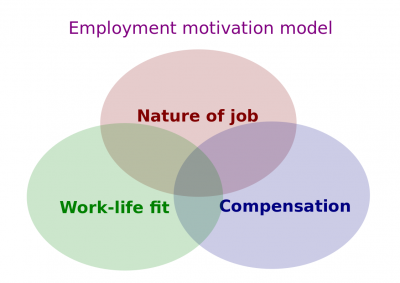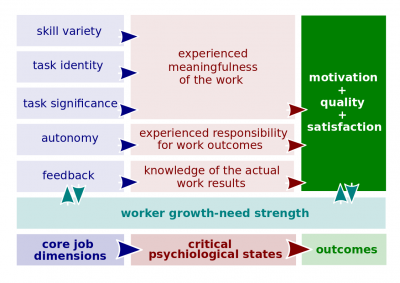Difference between revisions of "Nature of Work"
(→Employment motivation) |
(→Summary) |
||
| Line 49: | Line 49: | ||
===Summary=== | ===Summary=== | ||
| + | :This concludes the ''byby'' presentation. We have taken a look at [[]]. If you haven't done yet so, you are now welcome to move to [[byby]]. | ||
==Quiz questions== | ==Quiz questions== | ||
Revision as of 15:43, 26 January 2019

Work Environments is the third presentation in the Introduction to Employment lecture. The lecture itself is the second in WorldOpp Orientation. Consequently, the Orientation is the first stage of WorldOpp Pipeline.
This wikipage presents its full script and those test questions that are related to that presentation.
Script
The video of the presentation is published at https://youtu.be/r--p5fmz4TA (5:29). Here is its full text.
Overview
Welcome to Work Environments. In this brief presentation, we are going to take a look at two models, one for employment motivation and another for job characteristics. A separate stop will be made by task structures.
- Employment motivation model. A framework for analyzing employment motivation that identifies three domains that contribute to the motivation to work. These domains include job itself, its compensation, and its fit to one's life.
- Employee compensation. The cash compensation and employee benefits that an employee receives in exchange for the service he or she performs for their employer and/or for his or her time.
- Job characteristics model. A framework for analyzing and designing jobs that identifies five core job dimensions, their interrelationships, and their impact on outcomes. These core job dimensions include skill variety, task identity, task significance, autonomy, and feedback.
- Skill variety. The degree to which a job requires a variety of activities so that an employee can use a number of different skills and talents.
- Task identity. The degree to which a job requires completion of a whole and identifiable piece of work.
- Task significance. The degree to which a job has a substantial impact on the lives or work of other people.
- Autonomy. The degree to which a job provides substantial freedom, independence, and discretion to the individual in scheduling work and determining the procedures to be used in carrying it out.
- Feedback. The degree to which carrying out the work activities required by a job results in the individual obtaining direct and clear information about the effectiveness of his or her performance.
- Task structure. A set of structural job characteristics with which the worker interacts.
- Consequence of error. How serious would the result usually be if the worker made a mistake that was not readily correctable?
- Degree of automation. How automated is the job?
- Freedom to make decisions. How much decision making freedom, without supervision, does the job offer?
- Frequency of decision-making. How frequently is the worker required to make decisions that affect other people, the financial resources, and/or the image and reputation of the organization?
- Impact on enterprise. What results do your decisions usually have on other people or the image or reputation or financial resources of your employer?
- Importance of being exact (or accurate). How important is being very exact or highly accurate in performing this job?
- Importance of repeating same tasks. How important is repeating the same physical activities (e.g., key entry) or mental activities (e.g., checking entries in a ledger) over and over, without stopping, to performing this job?
- Level of competition. To what extent does this job require the worker to compete or to be aware of competitive pressures?
- Structured versus unstructured work. To what extent is this job structured for the worker, rather than allowing the worker to determine tasks, priorities, and goals?
- Time pressure. How often does this job require the worker to meet strict deadlines? How important is it to this job that the pace is determined by the speed of equipment or machinery? (This does not refer to keeping busy at all times on this job.)
- Work schedule. How regular are the work schedules for this job and what is the number of hours typically worked in one week?
- Work virtualization. The degree to which work is done remotely rather than at some specific physical location.
Employment motivation
We will start with employment motivation model which suggests that three demands are responsible for keeping us motivated on the jobs. The first is the job itself, the second is compensation for the job. Compensation consists of both cash and non-cash benefits and the third domain is life fit, it`s fit to ones life. Which can be a fit to ones’ values, lifestyles or schedules. Basically what a person has outside the job. Every one of these domains have both motivations and demotivation, so some factors can motivate us and some can demotivate us.
There are several theories and the most popular I would say in organization behavior is job characteristics model which suggest or chunks job characteristics which motivate us in five core dimensions which are skill varieties, task identities, task significance and autonomy and feedback. The first three gives us a psychological state of experienced meaningfulness of the work. Autonomy experience responsibility for work outcomes, all three of these psychological states gives most of us motivational quality and satisfaction.
What are skills variety? Skills variety is degree to which job requires a variety of activities so we don`t get bored on the job. Task identity is the feeling that the job can be accomplished so you can see the progress and measure the progress so as to see where you are on these tasks. Tasks significance is the degree to which job requires or has substantial impact so it could be once again all three gives a meaningfulness in the job. Autonomy is the degree to which job provides substantial freedom, independence and discretion. And feedback is the degree to which carrying out the work activities required by job resolves an individual`s obtaining direct and clear about the effectiveness of his/her performance. Obviously all three core dimensions which are responsible according to the theory form motivation, doesn`t cover all job characteristics. Taking a look at consequences of error, it`s definitely an adjusting factor. If the consequence is huge, why would anyone like to have more autonomy, probably it`s better to have some kind of a backup.
The same degree of automation, some jobs are more automated some jobs are not. Some are more scared of computers and robots, some are less. Of course we have freedom to make decisions, frequency of decision making, impact on enterprise, importance of being exact and a level of competition, some jobs are more competitive some are less, time pressure, work schedule and work virtualization. For instance, we Educaship Alliance LLC tend to work more virtual rather than physical. To sum up, we talked about working environments, we have taken a look at employment motivation model, job characteristics model, and we touched a little bit to structure and the next will be competencies required at work.
Summary
- This concludes the byby presentation. We have taken a look at [[]]. If you haven't done yet so, you are now welcome to move to byby.
Quiz questions
- Every statement below is split into one true and one false question in the actual exam.
See also
- Work Competences. The last presentation in Introduction to Employment.
- Nature Of Occupations. The second presentation in Introduction to Employment.


